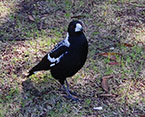Kulbardi and Wardong - Reverend Sealin Garlett
As recounted by Traditional owner and long-time Cockburn resident Reverend Sealin Garlett, this story uses two birds found commonly in this area to provide moral advice.
Long before there were any birds, this is when everybody was human, there were two brothers who lived in a camp. These two brothers were ngoonies and they were really close. They hunted together. They made spears and boomerangs together. On this particular day, they went hunting. They were good hunters and they were able to get goanna and kangaroo, the yongka, and they were cooking this on the ground. They said, `we'll cook this and take it back to camp, we will cook it up for the young fellas, so they don`t have to worry about making a fire when we get home.'
Anyway, when they were cooking the meat, they had the goanna on one side and the kangaroo in the fire, and when it was cooking, the older brother got up and stood behind his younger brother and he said, `hey, you know what, ngoon,' he said, `I seen a good bush over there that's really straight, a really good strong bush for boomerangs. We should go and camp there for a while.' The younger brother felt a little bit shame because where he lived, he was close to his parents, little sibling and the old people, so he said, `no, I don`t feel like moving.'
The older fella thought that this is what he was going to teach him in law, in Aboriginal way, so he said `no, I think we should go. I think you're at an age now where you have to learn some of these things. I have to be the one to help you do that.' The younger fella said, `well, wait till next time and maybe I will go.' This made the other brother angry and he started pushing him on the shoulder. The younger brother put his head down, because you know it's shame to argue with your older brother.
When the other fella went quiet, he went moorlap, see, he wouldn't talk. The older brother got angry and he picked up a boomerang and hit him on the side of the head. The younger brother fell down next to the fire and all the ashes got on his shoulder and went on his chest and on his arm. He rolled around on the dirt, trying to get the hot ash off him. And the older brother picked up a spear. He wasn't going to throw it, he was just going to jab it in his leg.
So he picked the spear up and as he was about to push it into his brother's leg a voice said, `Stop!' and he froze. He listened to see how many people there was, but there's no footsteps. Then he put his head down and straightened up and dropped his spear. He knew who it was. The younger brother, who was burnt, sat up. Anyway, the older one sat down and waited and wouldn't lift his eyes up.
Then the spirit said to these two boys, `you know, in your culture, I give you the spirit of unity. I give the spirit of being able to care for one another, but you draw blood from this young boy. You stood over this young boy like a master and that's not what I give you in Aboriginal way. I'm going to separate you boys.' The older brother started to shuffle about and move his feet in the dirt. Then the spirit said, `I'm going to turn you into a crow.' And the spirit turned him into a crow and the Nyungars were to call him wardong. The wardong went away, and to the fella sitting on the ground, he said, `I'm going to turn you into a magpie, your Nyungar name is kulbardi, and you can go away too.'
So these two brothers left. That's how the family of the crow and the magpie began. And if you ever notice today, a crow will never, ever go and share his meal with the magpie, very seldom. A crow will come over and try to boss and shoo the magpie away, or the magpie will go sit over there, while the old fella finished the meal, but very seldom will you find them together, sharing a meal. That was a Nyungar story representing not only the brokenness, but the healing that's got to take place in our Aboriginal culture of today.1
References
1. Collard, L., S. Harben & R. van den Berg. Nidja Beeliar Boodjar Noonokurt Nyininy: a Nyungar interpretive history of the use of Boodjar (country) in the vicinity of Murdoch University, Perth Western Australia. Murdoch University. 2004. Accessed November 2, 2012. http://wwwmcc.murdoch.edu.au/multimedia/nyungar/





 Kulbardi
Kulbardi